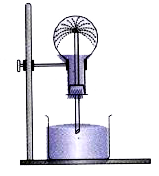The diagram shows set up for a simple experiment.

Describe the reactions taking place at
The copper electrode.
Text Solution
The aqueous solution of sodium chloride contains the following ions :
From NaCl(aq):Na+(aq) and Cl−(aq)
From H2O(l):H+(aq) and OH−(aq)
Sodium is above hydrogen in the reactivity series. Sodium ions remain in the solution and H+ ions accept electrons from the copper foil to form hydrogen gas.
2H+(aq)+2e−→H2(g) (Reduction)
So, H2 gas produced at the copper electrode.
|
Topper's Solved these Questions
- FOOTSTEPS TOWARDS CBSE BOARDBOOK - MTG IIT JEE FOUNDATIONCHAPTER - FOOTSTEPS TOWARDS CBSE BOARDEXERCISE - SECTION - B
34 Videos
- FOOTSTEPS TOWARDS (JEE MAIN) BOOK - MTG IIT JEE FOUNDATIONCHAPTER - FOOTSTEPS TOWARDS (JEE MAIN) EXERCISE - Integer/Numerical Value Type
5 Videos
- METALS AND NON METALS BOOK - MTG IIT JEE FOUNDATIONCHAPTER - METALS AND NON METALS EXERCISE - Olympiad/HOTS Corner
20 Videos
Similar Questions
Knowledge Check
During the electrolysis of the aqueous solution of copper sulphate using Pt electrode, the reaction taking place at anode electrode is
ACu2++2e−→CuBCu→Cu2++2e−C2H2O→4H⊕+O2+4e−DH2O+e−→c−OH+1/2H2During the electrolysis of the aqueous solution of copper sulphate using Pt electrodes , the reaction taking place at anode electrode is
ACu2++2e−→CuBCu→Cu2++2e−C2H2O→4H⊕+O2+4e−DH2O+e−→ΘOH+1/2H2In a cell of normal hydrogen electrode and calomel electrode, the electrode reaction taking place at calomel electrode will be
AHg2CI2(s)→2Hg(I)+2CI−+2e−B2Hg(I)+2CI−→Hg2CI2(s)+2e−CHg2CI2(s)+2e−→2Hg(I)+2CI−Dnone of these.
During the electrolysis of the aqueous solution of copper sulphate using Pt electrode, the reaction taking place at anode electrode is
View SolutionDescribe a simple experiment for measuring the surface tension of a liquid.
View SolutionDescribe a simple experiment for measuring the surface tension of a liquid.
View SolutionDescribe a simple experiment to carry out the distillation of water.
View SolutionThe diagram shows a simple arrangement of the fountain experiment:
What is the common property demonstrated by this experiment?

View Solution

